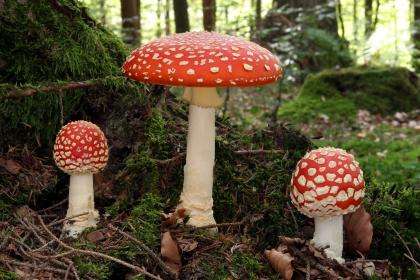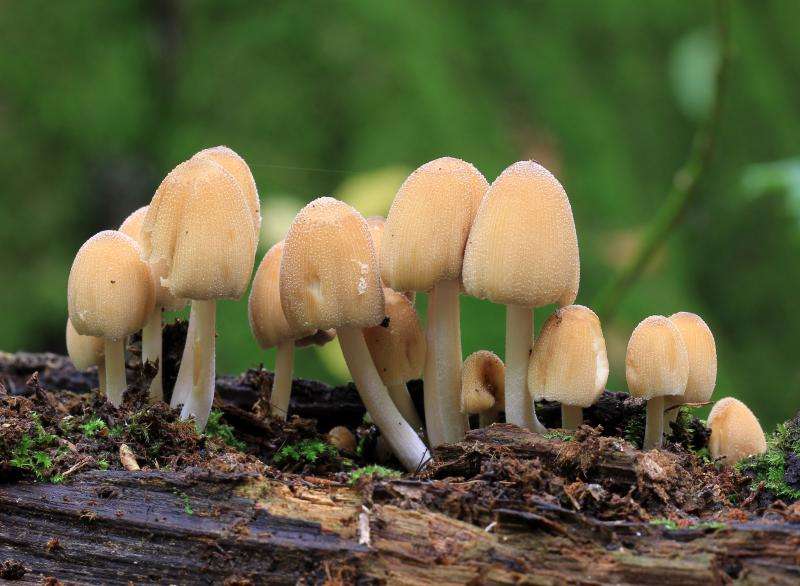Hijacked cell division helped fuel rise of fungi

A new study finds that the more than 90,000 species of mushrooms, molds, yeasts and other fungi found everywhere in the soil, water and air may owe their abilities to grow, spread, and even cause disease to an opportunistic virus they caught more than a billion years ago.
In the May 10 issue of eLife, researchers from Duke University and Stanford University suggest that a viral protein may have invaded the genomes of early fungi and hijacked their cell division control machinery, duping fungi into making more viruses as the fungal cells grew and divided. The viral protein was eventually adopted by its host and incorporated into the fungal genome, generating a family of proteins that are now critical to producing spores, invading host tissues and other fungal characteristics.
"The event could have triggered or facilitated the emergence of the entire fungal kingdom," said lead author Nicolas Buchler, assistant professor of biology at Duke.
The research could one day help scientists develop new types of antifungal drugs that inhibit cell division in fungi but not in their plant or animal hosts, Buchler said.
The cycle of cell growth and division is under tight control. Without it, living things couldn't go from a single fertilized egg to an adult, replace worn-out cells or heal from damage. Unchecked, cell division can lead to cancer in humans and other animals.
Studies in recent decades have shown that the molecular machinery plants and animals use to control this process includes some proteins that bear little similarity to their counterparts in fungi.
In plants and animals, a family of proteins called E2F transcription factors control the early stages of cell division, turning genes on and off as needed as one cell prepares to split into two. A different protein called SBF plays the same role in fungi.

Which raises the question: If the cell cycle control proteins in animals and plants are more or less the same, how did a protein that serves the same function in fungi—which are more closely related to animals than either group is to plants—come to be so different?
To find out, Buchler and colleagues scoured the genome sequences of hundreds of eukaryotes, the group of living things that includes all fungi, plants and animals, including humans.
They checked amoebas, algae, and other organisms for cell cycle control proteins similar to the SBF protein found in fungi, but nothing turned up.
The only matches weren't in plants or animals at all, but in viruses. The results suggest that fungi acquired their SBF protein independently after diverging from animals about a billion years ago, most likely from a virus that infected the fungal ancestor's cells and infiltrated its genome.
The virus likely commandeered its host's cell cycle controls for its own benefit, but fungi may have found the protein useful and adopted it through a process known as horizontal gene transfer.
By zeroing in on these virally-derived genes, which now play key roles in fungal growth, scientists may be able to identify new ways to fight fungi that cause disease, the researchers say.
Life-threatening fungal infections such as cryptococcal meningitis and fungal pneumonia kill one and a half million people every year. Such infections can be especially dangerous for people with impaired immune systems, including organ transplant recipients or those with cancer or HIV.
Fungal pathogens aren't limited to people. Rotting and plant disease in crops, white-nose syndrome in bats and colony collapse disorder in bees are all caused by fungi.
Now the researchers are trying to understand how the cell cycle control machinery of fungi was co-opted without wreaking havoc on the life of the cell.
They are focusing on fungi that branched off early, near the base of the fungal family tree, such as soil-dwelling fungi called chytrids. Cell division in these species is thought to be controlled by both the E2F protein family and the SBF protein unique to fungi. The pattern suggests that fungal evolution went through a transitional state where both cell cycle controllers coexisted in the ancestor of most fungi, and then E2F was lost and replaced by its viral stand-in.
In experiments with the single-celled fungus Saccharomyces cerevisiae, or brewer's yeast, Buchler and colleagues show that the SBF proteins in yeast can bind to the same snippets of DNA as their E2F counterparts in animals, which supports the idea that SBF was able to take over by activating the same gene targets its predecessor did.
"The fungal cell cycle never stopped, it just went through a period where it had two control switches competing for the same genetic real estate," Buchler said.
More information: Edgar M Medina et al, Punctuated evolution and transitional hybrid network in an ancestral cell cycle of fungi, eLife (2016). DOI: 10.7554/eLife.09492
Journal information: eLife
Provided by Duke University




















